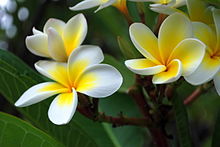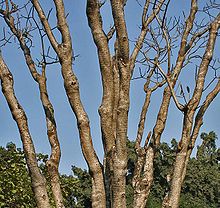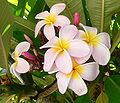- Plumeria
-
"Frangipani" redirects here. For other uses, see Frangipani (disambiguation).
Plumeria 
Plumeria sp. Scientific classification Kingdom: Plantae (unranked): Angiosperms (unranked): Eudicots (unranked): Asterids Order: Gentianales Family: Apocynaceae Subfamily: Rauvolfioideae Tribe: Plumerieae Genus: Plumeria
L.[1]Species Plumeria alba
Plumeria bracteata
Plumeria clusioides
Plumeria obtusa
Plumeria pudica
Plumeria rubra[2]Plumeria (common name Frangipani) is a genus of flowering plants of the family that includes Dogbane: the Apocynaceae.[1] It contains 7-8 species of mainly deciduous shrubs and small trees. They are native to Mexico, Central America, the Caribbean, and South America as far south as Brazil[3] but have been spread throughout the world's tropics.[citation needed]
Contents
Description
Plumeria is related to the Oleander, Nerium oleander, and both possess a irritating, milky sap, rather similar to that of Euphorbia. Contact with the sap may irritate eyes and skin.[4] Each of the separate species of Plumeria bears differently shaped alternate leaves, with distinct form and growth habits. The leaves of P. alba are quite narrow and corrugated, whereas leaves of P. pudica have an elongated shape and glossy, dark-green color. P. pudica is one of the everblooming types with non-deciduous, evergreen leaves. Another species that retains leaves and flowers in winter is P. obtusa; though its common name is "Singapore," it is originally from Colombia.
Plumeria flowers are most fragrant at night in order to lure sphinx moths to pollinate them. The flowers have no nectar, and simply dupe their pollinators. The moths inadvertently pollinate them by transferring pollen from flower to flower in their fruitless search for nectar.
Plumeria species may be easily propagated from cuttings of leafless stem tips in spring. Cuttings are allowed to dry at the base before planting in well-drained soil. Cuttings are particularly susceptible to rot in moist soil. Propagation can also be by tissue culture from cuttings of freshly elongated stems or aseptically germinated seed. Pruning is best accomplished in the winter for deciduous varieties, or when cuttings are desired.
There are more than 300 named varieties of Plumeria.
Etymology and common names
The genus, originally spelled Plumiera, is named in honor of the seventeenth-century French botanist Charles Plumier, who traveled to the New World documenting many plant and animal species. The common name "Frangipani" comes from an Italian noble family, a sixteenth-century marquess who invented a plumeria-scented perfume. Many English speakers also simply use the generic name "plumeria". In Hawaii, the name is "melia". In Sri Lanka, it is referred to as araliya and (in English) as the Temple Tree. In Cantonese it is known as, 'gaai daan fa' or the 'egg yolk flower' tree.
In culture
These are now common naturalised plants in southern and southeastern Asia. In local folk beliefs they provide shelter to ghosts and demons. The scent of the Plumeria has been associated with a vampire in Malay folklore, the pontianak. They are associated with temples in both Hindu and Buddhist cultures.
In several Pacific islands, such as Tahiti, Fiji, Samoa, Hawaii, New Zealand, Tonga, and the Cook Islands Plumeria species are used for making leis.[5] In modern Polynesian culture, it can be worn by women to indicate their relationship status - over the right ear if seeking a relationship, and over the left if taken.
P. alba is the national flower of Nicaragua and Laos, where it is known under the local name "Sacuanjoche" (Nicaragua) and "Champa" (Laos).
In Bangladeshi culture most white flowers, and, in particular, plumeria (Bengali, চম্পা chômpa or চাঁপা chãpa), are associated with funerals and death.
In the Philippines and Indonesia, Plumeria, which is known in Tagalog as calachuchi, is often associated with ghosts and graveyard. Plumerias are often planted on cemetery grounds in both countries. Balinese Hindus use the flowers in their temple offerings.
Indian incenses containing Plumeria have "Champa" in their name, for example Nag Champa.
In Hindu mythology[citation needed], there is a saying "चम्पा तुझमें तीन गुण - रंग, रूप और बास ; अवगुण तुझमें एक ही कि भंवर न आए पास" (Hey Champa you have three qualities color, beauty, and fragrance, but the only thing you lack is that honey-bees never sit on you.)"roop tajey to Radhikey, or bhanwar Krishna ko daas, is mariyaadey ke liye bhanwar na aaye pass" (the beauty of champa is compared to Radhika, who is wife of lord Krishna and honey-bees are servants of Lord Krishna and this is the reason honey-bees don't sit on the champa flower.)
In Sri Lankan tradition, Plumeria is associated with worship. One of the heavenly damsels in the frescoes of the 5th-Century rock fortress Sigiriya holds a 5-petalled flower in her right hand that is indistinguishable from Plumeria.[6]
In Eastern Africa, frangipangi are sometimes referred to in Swahili love poems.[7]
Literary occurrences
- 1819 - P. B. Shelley "The champak odours fail / Like sweet thoughts in a dream," line from "Indian Serenade".[8]
- 1884 - In Huysmans's "À rebours" the persistent odor of frangipani troubles Jean des Esseintes.
- 1890 - In Oscar Wilde's The Picture of Dorian Gray, Lord Henry's wife's perfume leaves the scent of frangipani to linger in the room, likely referencing the work of Huysmans.
- 1905 - Sarojini Naidu "Where upon the champa boughs the champa buds are blowing;" line from the poem entitled 'Village-Song' from her collection entitled The Golden Threshold.[9]
- 1913 - Rabindranath Tagore story entitled 'The Champa Flower' from the collection Crescent Moon.[10][11]
- 1957 - Doris Lessing's short story Flight, from her collection 'The Habit of Loving' includes several references to the frangipani tree - "Her hair fell down her back in a wave of sunlight, and her long bare legs repeated the angles of the frangipani stems; bare, shining-brown stems among patterns of pale blossoms."[12]
- 1978 - Panama novel by Thomas McGuane "But I looked down through spinning air filled with frangipani and rock and roll and saw how quickly you are alone..."
- 1996 - "Under the Frangipani" (A Varanda do Frangipani) by Mozambican Mia Couto,[13] who allegorises the passage of time as the shedding of the tree's flowers and the protagonists' departure from their shattered world as merging into the tree's roots.
Selected species
- Plumeria alba L.
- Plumeria bracteata L.
- Plumeria clusioides Griseb.
- Plumeria obtusa L.
- Plumeria pudica Jacq.
- Plumeria rubra L.
- edit] Formerly placed here
- Himatanthus lancifolius (Müll.Arg.) Woodson (as P. lancifolia Müll.Arg.)[2]
Gallery
-
Red frangipani found in Malaysia.
-
White Plumeria, found at Andhra Pradesh
References
- ^ a b "Genus: Plumeria L.". Germplasm Resources Information Network. United States Department of Agriculture. 2003-03-14. http://www.ars-grin.gov/cgi-bin/npgs/html/genus.pl?9609. Retrieved 2010-09-08.
- ^ a b c "GRIN Species Records of Plumeria". Germplasm Resources Information Network. United States Department of Agriculture. http://www.ars-grin.gov/cgi-bin/npgs/html/splist.pl?9609. Retrieved 2010-09-08.
- ^ Urs Eggli, ed (2002). Illustrated Handbook on Succulent Plants. 5: Dicotyledons. Springer. p. 16. ISBN 9783540419662. http://books.google.com/books?id=ffBRAyZLuh0C&.
- ^ College of Tropical Agriculture and Human Resources (CTAHR). Ornamentals and Flowers. Feb. 1998. OF-24.
- ^ Jones, Jay (April 22, 2008). "Hawaii keeps the lei-making tradition alive". Los Angeles Times. http://travel.latimes.com/articles/la-tr-leis27apr27.
- ^ Kottegoda, S R, Flowers of Sri Lanka, Colombo, Royal Asiatic Society of Sri Lanka, 1994; pp xiii-xiv
- ^ Knappert, Jan (1972) An Anthology of Swahili Love Poetry, University of California Press, page 93. ISBN 0520021770
- ^ Poetry-archive.com
- ^ Gutenberg.org
- ^ Sacred-texts.com
- ^ Tagore, Rabindranath (1913, new edition 2007) Crescent Moon — Child Poems, Standard Publications Inc, ISBN 159462738X
- ^ Lessing, Doris (1957) The Habit of Loving, Crowell. ISBN 0261616064
- ^ Couto, Mia (1996) A Varanda do Frangipani: Romance (Uma Terra Sem Amos), Caminho. ISBN 9722110500
External links
- Plumeria at the Open Directory Project
- edit] Formerly placed here
Categories:
Wikimedia Foundation. 2010.








